IELTS TUTOR cung cấp The Science of “Sleeping on It”: Đề thi thật IELTS READING (IELTS Reading Recent Actual Test) - Làm bài online format computer-based, , kèm đáp án, dịch & giải thích từ vựng - cấu trúc ngữ pháp khó & GIẢI ĐÁP ÁN VỚI LOCATION
I. Kiến thức liên quan
II. Làm bài online (kéo xuống cuối bài blog để xem giải thích từ vựng & cấu trúc cụ thể hơn)
📩 MN AI CHƯA CÓ ĐÁP ÁN FORECAST QUÝ MỚI PART 1-2-3 NHẮN ZL 0905834420 IELTS TUTOR GỬI FREE HẾT NHA
III. The Science of “Sleeping on It” Đề thi thật IELTS READING (IELTS Reading Recent Actual Test)
The Science of “Sleeping on It”
A Each one of us has experienced a wide array of dreams, from the funny and romantic to the terrifying and bizarre. In dreams, bits of reality, imagination, and memory intermingle in nonlinear narratives that often make little sense upon awakening. Dreams seem to be related to a reshuffling of memories, and indeed, it is often said that studying before sleep is a good way to retain information. When people say they will "sleep on" a decision or problem, it is likely because they know they will awaken the next day with a clearer solution in mind, and scientific evidence has shown that this is in fact the case.
B To test whether or not sleep really does play a role in solving difficult problems, researchers at Northwestern University conducted a study in which they presented participants with a series of tricky, carefully designed puzzles, each of which participants had two minutes to figure out. During this time, a unique sound clip would play in the background, and a new sound clip would be played with each new puzzle. After this initial stage of the experiment, which always took place in the early evening, members of the study group were sent home with some specialized equipment that monitored their sleep and played some of the sound clips they heard while attempting the puzzles in the lab. The ensuing morning, they all returned to the lab to try to solve the puzzles that stumped them the previous night. Their success rate improved across the board, but the most marked improvement was in puzzles that were associated with sound clips they had heard while sleeping, solving 32% of the sleep-cued puzzles, compared to only 21% of the un-cued puzzles.>> Form đăng kí giải đề thi thật IELTS 4 kĩ năng kèm bài giải bộ đề 100 đề PART 2 IELTS SPEAKING quý đang thi (update hàng tuần) từ IELTS TUTOR
C A study on the benefits of napping, headed by Sara Mednick, assistant professor of psychiatry at University of California San Diego, and Denise Cai, a graduate student, revealed that rapid eye movement (REM) sleep enhances creative problem solving. The findings of this study may have implications for how sleep, and REM sleep in particular, promotes the formation of associative creative problems that you've already been working on - the passage of time is enough to find solutions. However, for new problems, only REM sleep enhances creativity." Mednick believes that REM sleep does this because it stimulates associative networks, which allow the brain to make connections between unrelated concepts or ideas.
D According to Robert Stickgold, professor of psychiatry at Harvard Medical School states that "when you get into bed, the brain does a triage and 'rifles through the events of the day and sees what's left unfinished." The brain picks out emotions that occurred during or shortly after something happened, and uses these memory cues to indicate that the event was important and needs to be analyzed further. Stickgold believes that there are two key elements at play here, the first being that the prefrontal cortex shuts down. This region of the brain is in charge of executive decision-making, along with rational thinking and impulse control. With the prefrontal cortex shut down, there are no categories into which ideas can be sorted, allowing the brain to freely associate and process information in the background. The other factor at play is that when we enter REM sleep, the neuromodulators norepinephrine and serotonin are turned off. Norepinephrine enhances focus on immediate issues, and it is believed that the brain is biased into placing higher value on loose connections when serotonin is turned off. With both neurochemicals dormant, parts of ideas come together as one.
E Mark Beeman, a professor of psychology at Northwestern University, stated: 'There was this idea that during sleep the brain is resting, but now we know there's a lot of important work being done" following research by his team. While we sleep, our brains sort, consolidate, and store new information, and we "walk through" memories of recent events. This rehearsal appears to distinguish meaningful patterns from unhelpful "background noise." Beeman believes that this can be useful in problem-solving and provides an explanation as to why playing sound clips associated with certain puzzles facilitate this type of rehearsal. "This research adds to a growing list of literature suggesting that sleep can reorganise information to facilitate problem-solving." says Kristin Sanders, first author of the study and a doctoral student at Northwestern University. Sanders, first author of the study and a doctoral student at Northwestern University. "It also suggests that a replay of the problem memory during sleep is critical for this reorganisation." Sanders also goes on to explain that "problem solving is part of everyone's daily life; while we use tricky puzzles in our study, the underlying cognitive processes could relate to solving any problem on which someone is stuck or blocked by an incorrect approach." However, she warns that this can only be applied to situations in which one already has some background knowledge or information. For example, this effect would not help someone find a cure for a rare disease if they are not already working on this problem.
F Some researchers also believe that dreams have an evolutionary basis, and that our ability to dream may have indeed evolved from the need to solve problems. "Dreams are thinking or problem-solving in a different biochemical state from that of waking." writes the Harvard psychologist Deirdre Barrett in The New Science of Dreaming. According to Barrett, all functions of the brain must have some practical usage, and are rooted in evolution and natural selection, which may explain why the brain utilizes dreams to help break down, analyze, and solve problems.
G Before we fall asleep, the brain wants to acknowledge a thought and move on to the next one, but in reality, we tend to latch onto one thought and ruminate on it, and then feelings of regret start to set in, triggering an adrenaline rush, according to Stickgold. It is helpful to acknowledge a thought and let it go by without passing judgment, similar to the calming methods used in meditation. However, if a particular thought won't go away, there are calming steps that can be taken. Stickgold states that "there is nothing wrong with checking," and for issues that can not be resolved right away, it is acceptable to keep a notepad and pencil nearby to write down a reminder for the following day. Getting up in the middle of the night to work on a problem, however, is not particularly helpful, as it will just leave you exhausted in the morning without having gotten any closer to an answer. The best solution is in fact to just let the ideas pass through your mind unimpeded.
Questions
Questions 14 - 17:
Write the correct letter, A–G, on your answer sheet.
14 a mention of the limitations of using sleep to help solve problems
15 a reference to how an activity before sleep can help with information recall
16 a contrast between what the brain wants to do and what we actually do
17 an explanation of why we have dreams
Questions 18 - 22:
Choose NO MORE THAN TWO WORDS from the passage for each answer.
A study at Northwestern University was conducted in which participants had to solve puzzles that were accompanied by a 18 ________. Following this first phase, they went home with equipment that monitored their sleep and played sounds that they had heard in the lab, and the following morning, their 19 ________ improved, especially for puzzles cued with sounds that they had heard in their sleep.
A study by Sara Mednick showed that REM sleep was beneficial for creative 20 ________, and that REM sleep allows the brain to create associations between previously 21 ________ ideas. Professor Robert Stickgold mentions that the brain selects 22 ________ that are connected to an event and uses these memory signals to decide if something was important.>> IELTS TUTOR gợi ý tham khảo CẦN VIẾT & THU ÂM BAO NHIÊU BÀI ĐỂ ĐẠT 8.0 SPEAKING & 7.0 WRITING?
Questions 23 - 26:
Match each statement with the correct researcher, A, B, C, D, or E.
23 going over memories helps differentiate between useful and trivial information
24 staying up late is not effective for trying to solve problems
25 information related to a problem can be restructured during sleep
26 all the functions of the brain must have evolved to serve a particular purpose
List of Researchers
A Sara Mednick
B Robert Stickgold
C Mark Beeman
D Kristin Sanders
E Deirdre Barrett
IV. Dịch bài đọc The Science of “Sleeping on It”

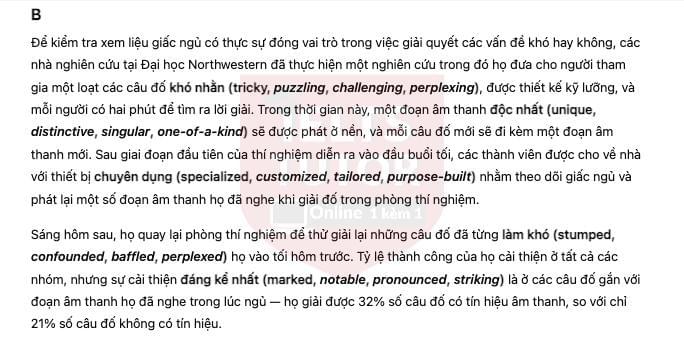
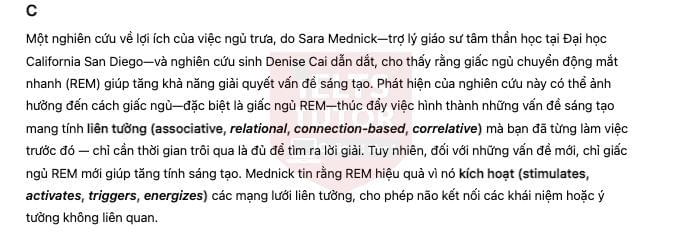
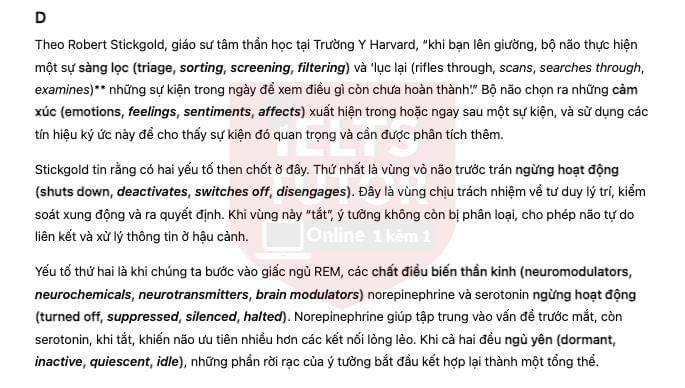

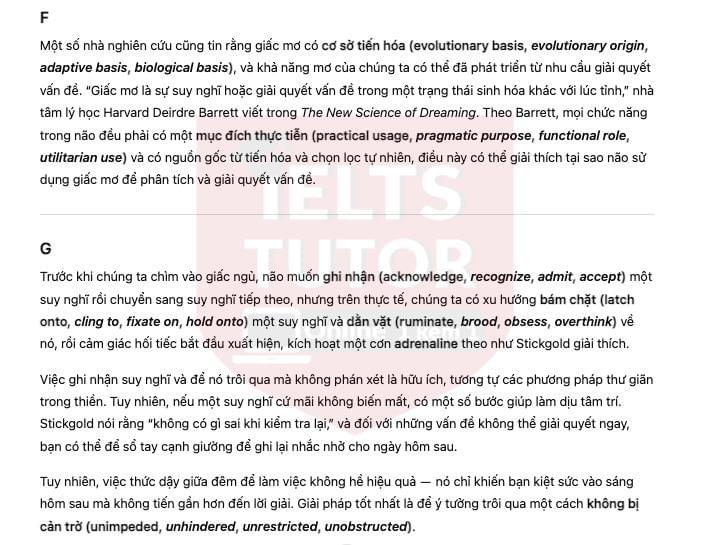
V. Giải thích từ vựng The Science of “Sleeping on It”
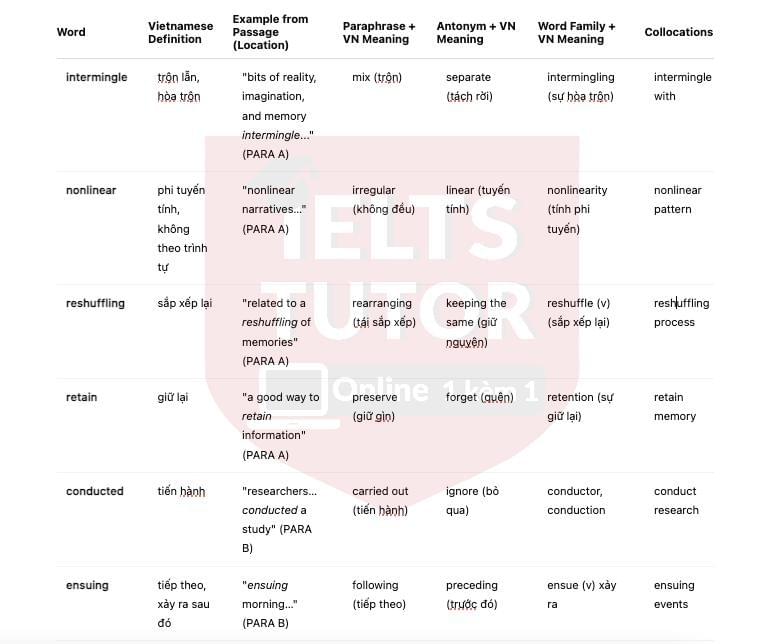
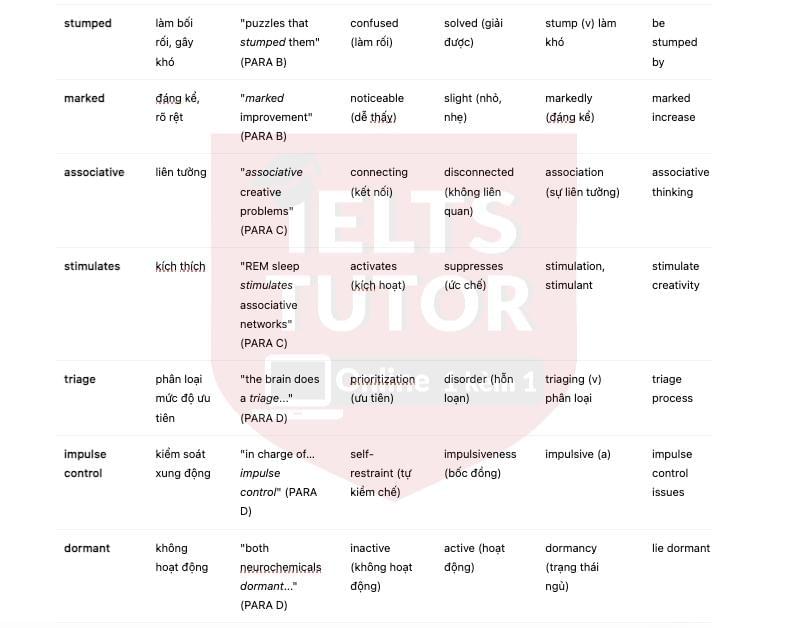
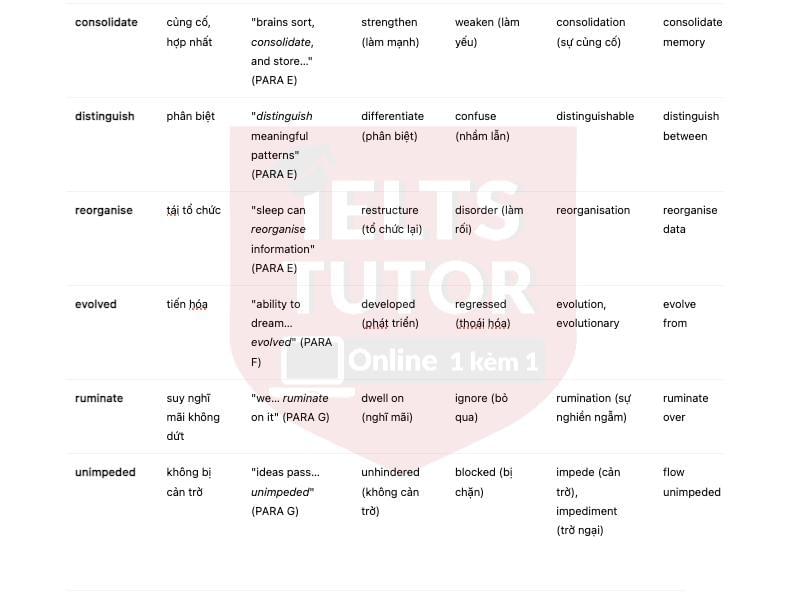
VI. Giải thích cấu trúc ngữ pháp khó The Science of “Sleeping on It”
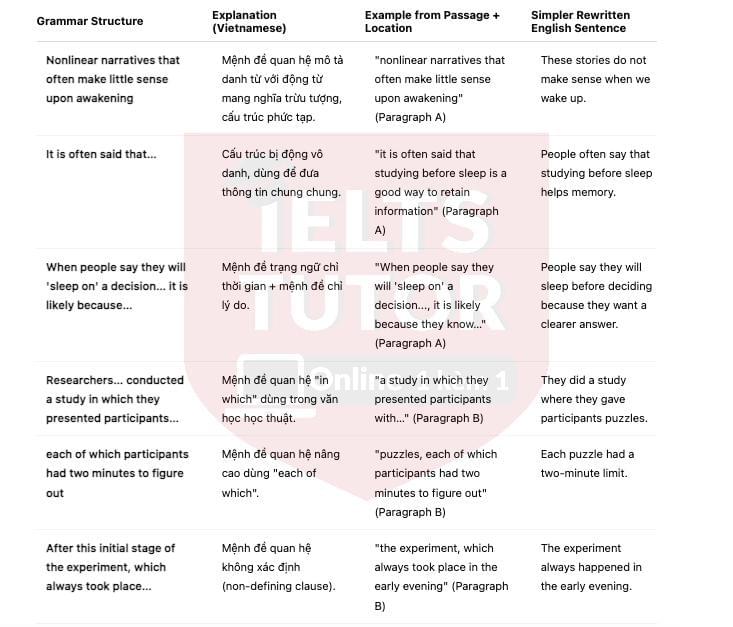


VII. Đáp án The Science of “Sleeping on It”



14 E
15 A
16 G
17 F
18 sound clip
19 success rate
20 problem solving
21 unrelated
22 memory cues
23 C
24 B
25 D
26 E
📩 MN AI CHƯA CÓ ĐÁP ÁN FORECAST QUÝ MỚI PART 1-2-3 NHẮN ZL 0905834420 IELTS TUTOR GỬI FREE HẾT NHA

Các khóa học IELTS online 1 kèm 1 - 100% cam kết đạt target 6.0 - 7.0 - 8.0 - Đảm bảo đầu ra - Thi không đạt, học lại FREE
>> Thành tích học sinh IELTS TUTOR với hàng ngàn feedback được cập nhật hàng ngày

